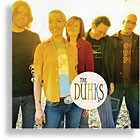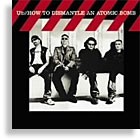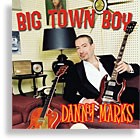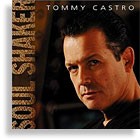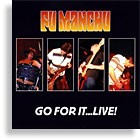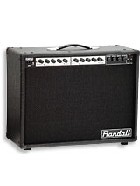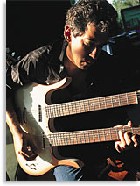At the end of his clinic at the National Guitar Workshop in July, after two information-packed hours of tips on equipment, technique, session work, and more, David Grissom was asked, “When you were a teenager starting to play guitar, did you ever think you would do all the things you’ve done? Were you hungry at an early age?”
He answered, “I was definitely hungry to do things that I wound up doing. I never expected it, but I was on a mission. It was my church, my spiritual thing. There was something that happened when I could improvise, and still does, that feels like nothing else. Having said that, a lot of things happened that were unbelievable – whether it was touring with Joe Ely or the first time playing with John Mellencamp. Yeah, this is what I wanted to do, but when it happened it was incredible. And you realize, it’s not putting a list on your resume; it’s finding the next thing, keeping your heart and fire going. When you do things you’ve sort of dreamt about, it doesn’t always feel like you think it’s going to feel in the long run, but the journey is more fun than getting there.”
That journey has taken Grissom from his hometown of Louisville, Kentucky, to Bloomington, Indiana, to Austin, Texas, and Nashville, not to mention countless miles on the road. It has included stints with Ely and Mellencamp, five years with the band Storyville, a call from the Allman Brothers to sub for Dickey Betts on 24 hours notice, and a spot as guitarist/bandleader for the Dixie Chicks’ 2003 “Top Of The World Tour,” resulting in live CD and DVD counterparts.
Along the way, sessions have cropped up with Robben Ford, Ringo Starr, John Mayall, Lee Ann Womack, Chris Isaak, Buddy Guy, Montgomery Gentry, the Fabulous Thunderbirds, John Anderson, Shannon Curfman, Pat Green, Martina McBride, Kevin Welch, James McMurtry, Charlie Robison, Pam Tillis, Jack Ingram, Bruce Robison, Webb Wilder, the Texas Tornados, and Jennifer Warnes. And besides shouldering the lion’s share of the songwriting with Storyville, including the band’s trademark track, “A Good Day For The Blues,” his songs have been recorded by the aforementioned Mayall, Gentry, Womack, Curfman, and Wilder, as well as Billy Ray Cyrus, Trisha Yearwood, and others.
In the process, Grissom found time to release two excellent Hot Licks instructional videos – “Lone Star Electric Guitar, Parts 1 and 2” – and write a handy method book, A Guide To Blues/Rock Guitar Soloing (Cherry Lane).
But more impressive than (and largely to thank for) his diverse, growing resume is the fact that David Grissom has a unique, identifiable sound and attitude. In fact, his style has seeped into the fabric of other session players and sidemen.
A few days after his clinic, we sat in his studio outside of Austin, as he rehearsed for the “Vote For Change” shows, where he accompanied the Dixie Chicks and James Taylor.
Vintage Guitar: When people think of you, their impression is probably of this very spontaneous, aggressive, from-the-hip style. It wouldn’t dawn on anybody that the word “Mixolydian” would ever come into that paradigm. Does the technical aspect of what you’re doing flash through your mind as you’re playing?
David Grissom: It’s really just kind of under my fingers. I think there’s enough familiarity with the fingerboard that there’s a visual element, as well. In other words, if I’m looking at the neck while I’m playing, I can see the other notes around the note I’m playing; I can hear them by looking at the fretboard, relatively. You have a visual component where you can see where you want to go, the shape of the sound you want to make. Because my ear is developed to a certain point, if I’m closing my eyes and I’m playing the minor 3rd, I know where all the other notes are around that. So, “Here comes the II minor, so I should play the Dorian mode” was sort of something I did a long time ago; now I don’t think about it.
It seems almost contradictory for a guitar player who plays so from-the-gut to also be very disciplined.
I think initially it wouldn’t have been classified as discipline as much as just passion for it. I didn’t look at it as work; I just wanted to play all the time. I wanted to be able to play like B.B. King and then Duane Allman and Hendrix and then George Benson and Pat Metheny and Wes Montgomery, or Norman Blake. I couldn’t wait to wake up the next day, just to start trying to do it again. Like the “Sweet Little Lisa” solo by Albert Lee (from Dave Edmunds’ Repeat When Necessary), I worked on it for a year. I was just kind of consumed by it. Also, I would call my father very disciplined, in an inspiring way – an incredibly hard worker. I think a lot of that rubbed off on me.
I’ve been fortunate to work with some people who were pretty hard workers themselves, and when I started going to Nashville, I had a couple of friends who, when they didn’t have a session, would book time for a writing appointment. They worked every day. You realize that you don’t spend an hour every other day and expect to get to a different level. I guess now, because I’m involved in a lot more than just playing guitar, I do look at it as being disciplined. I could work here from 8:30 to 6:00.
I loved your answer to the “were you hungry” question at the clinic – because the typical response would be to rub your foot in the sand and say, “Aw shucks, in my wildest dreams, I had no idea.”
I consider myself a pretty humble person, and I tried to worm around that question in my head for a couple of seconds – but, no, there was never any question.
How formal was your guitar training?
At first, it was very informal. I started playing guitar when I was 12. My very first guitar teacher was Sam Todd. He taught me “House Of The Rising Sun” and “Sympathy For The Devil,” which I had never heard before. It’s E, D, and A. When I got home, I bought Get Yer Ya Yas Out – “There it is! They’re playing my song; I’m playing their song.” I was a really cool feeling.
Then I took lessons from a guy named Philip Franchini for a year and a half. “Here’s how you play an Eddie Taylor rhythm; here’s how you play a 9th chord, so you can play ‘Stormy Monday.’ Here’s the pentatonic scale; here’s the blues scale.” That was kind of the extent of theory at that point.
When I got with Jeff Sherman, who was a jazz player, that’s when I got most of my theoretical knowledge. I was 15 or 16 at that point. Each week, he would give me a jazz standard to learn – “Just Friends,” “St. Thomas.” That whole experience really expanded my horizons, harmonically. He turned me on to Wes Montgomery and Kenny Burrell. He got me on the Berklee books by William Levitt – A Modern Method For Guitar, Vols.1, 2, 3 – so I gradually learned to read a little bit and learned stuff like the whole major scale up and down the neck, and basic things like the treble clef, repeat signs, D.S., codas, the degrees of the major scale, the modes. And even in the [Nashville] number system, those things are written on charts. As rudimentary as that sounds, it became indispensable. Being able to read and write rhythms, which is the hardest part, is very important.
When did you go to Berklee?
I was there for six weeks at a summer program when I was 17, which is where I took lessons from Metheny. I also met Pat Martino, because he was playing at the jazz workshop, and his amp [quit] onstage. I offered to get my amp, so he put me on the guest list for the whole week, and I took a lesson from him. When I was 19 or 20, I went to Jimmy Raney’s house in Louisville, and we just got “The Real Book” out and played, trading off, and it was one of the most amazing experiences. He was such a kind, soulful guy, but we were playing “Out Of Nowhere” or something like that, and about 20 minutes into it, almost every note, I started to sound more like him. Just being in his presence.
Your influences cover a range of styles. A lot of good players who go through that learning process come out the other end sounding like a collection of those influences – like switching from T-Bone Walker to Magic Sam, like an impersonator. But they don’t have an identifiable style, something that’s uniquely theirs. Was that a goal that you shot for, or did it evolve on its own?
I wasn’t smart enough to have this grand scheme to develop “my style.” It evolved on its own. Truthfully, when I think about Norman Blake, Pat Metheny, B.B. King and the other influences, I think about a certain beauty and grace and power in the music. I don’t think about what guitar he plays or which strings he uses. There’s a quality in a lot of the guys I’m attracted to that I hear – a musicality and a depth of expression.
I didn’t make a conscious effort to learn some bluegrass, then some jazz; I think after a while I became aware of the fact that there were certain players who had developed their own niche – Metheny being one of them. When I heard Bright Size Life, it was like, “I don’t know what this is. I don’t understand this in the least, but it touches me on a very deep level.” When I heard Roy Buchanan for the first time, during the era of his first two albums – “I don’t know what this guy is doing, but it’s knocking me over.” It was powerful and otherworldly. He combined all those different styles and came up with his own thing.
Like him, you didn’t become a chameleon…
Or a musicologist. An academic, music-school thing – I have no interest in doing that. I wanted to leave some room to make it my own. I loved learning, and I think the more you know about music and theory, the more knowledgeable you are, the better. But there’s a certain music-school vibe that has nothing to do with music. I don’t think that knowing about music and learning about music and playing with fire are mutually exclusive. But the bottom line is, you’ve got to study in an environment that you can learn in for a certain amount of time, but then you’ve got to get out and start playing gigs.
The stereotype of musicians is that they don’t have any business sense. You, on the other hand, studied business at Indiana University.
Actually I went to music school [at IU] for a year, then went on the road for two years with a group called Streamwinner, with Kenny Aronoff on drums. Then I went back and got a finance degree. But while I got that finance degree, I was in a house country band, Sam Collins & The Hard Times Boys, every Friday and Saturday night at The Hopp, and then a band called the Last Safari, who covered everything from NRBQ to King Crimson to George Jones.
Was the finance degree to have something to fall back on, or did you have the foresight to realize that it would come in handy if you were going to become a professional musician?
It would give me something to fall back on, but at the same time I heard so many stories and saw firsthand so many people getting screwed over. To this day, I’ve never had a manager, and I do all my own negotiating. Every tour is a new negotiation, every record – unless you’re doing a union thing in Nashville, which is a godsend.
There have been times when I had to hire a lawyer to look it over, but I have to read book contracts, publishing deals. I understand how these things can be negotiated, and I understand points that can be given and taken away. Hopefully, people respect the fact that I know what I’m talking about. I’ve been doing this long enough, if somebody’s going to screw me over I can pretty much figure it out, and I have no patience for it. But there’s no excuse; anybody can go out and buy Everything You Need To Know About The Music Business by Donald Passman and read it in a week. Use it as a reference, whether you’re negotiating a management contract, a publishing deal, or to learn about how you make money when you write songs.
It’s idealistic to think, “All I care about is the music.” The reality is you’re going to get screwed over if you don’t at least take an interest in the business side.
How do you view Storyville, in hindsight?
After three years with John Mellencamp, I came back to Austin to regroup, and I had an offer to go play with Rod Stewart. But I chose Storyville, because in my gut I felt like it was something that had incredible potential. And it was a dream band, in a way, for what I wanted to do at the time. I think on a good night it was one of the most powerful bands I’ve ever been in, and I really like our first record, Piece Of Your Soul. All the pieces just were not in place. We started out as sort of a band of five leaders. We’d all been around the block and knew how the business worked. But it started out as five chiefs and became five Indians – from “I know what to do here” to “I don’t care; what do you want to do?” We just kind of gave it away or threw in the towel. That was a tough thing to go through, to have invested that much in something.
Pat Metheny once told me, “It’s my opinion that bands work best when there is clearly a leader.”
I agree. Any other way really doesn’t work; you just fight all the time. Storyville did not have a leader. It was death by democracy.
The title of your method book is Blues/Rock Guitar Soloing, yet you’re the bandleader of the Dixie Chicks and most of your session work is in Nashville.
I think I play “American guitar.” If I try to think about what defines my style or why I listened to these different players, I think it just comes back to a certain quality. Metheny is a very Midwestern guitar player, very uniquely American. Norman Blake is a uniquely American guitar player. From growing up in this country and traveling around – coming from Kentucky to Indiana and then Texas – you could say it’s “roots rock,” but it’s not really. I enjoy rootsy styles, but I enjoy modern players, too.
I think it just comes out of my experience in life and where I was brought up. I think losing my mother when I was 10 years old influenced my life in a very big way, and I think guitar was a way for me to have a way to express myself – whether it was grief or yearning for love or just something to transport me. That’s a quality I hear in B.B. King, in Albert King, and Albert Collins. I certainly hear it in Metheny; it takes me someplace else – I can’t put my finger on it.
After switching gears into session work, you were offered the job of lead guitarist and bandleader with the Dixie Chicks for an eight-month tour. How much did you have to think about it?
I had to think about it a lot; I had to talk to [wife] Shelli about it a lot. I was reluctant, because I was concerned it would cut into sessions. But I had a really good feeling when I talked to them, and the Home record, which I think is really great, had just come out. It really intrigued me that I’d be playing acoustic half the night, and it was heavily bluegrass-based. What a great opportunity to learn more about bluegrass.
The girls are really smart and really talented. When we were rehearsing, Lloyd Maines [producer and father of Dixie Chick Natalie Maines] said, “Hey, Grissom, did you ever think back when we were playing with Ely that you’d be working for my daughter one day?” (laughs).
Onstage, we all had in-ear monitors, so it was like playing in the studio. I could hear everything, and there was never an out-of-tune note. They’re real talented. It was a rewarding musical experience, and I really respect them as artists. I’m intrigued by what they’re going to do next; I have no idea.
How much of your playing with the Dixie Chicks is duplicating the parts off the records?
Like any situation, there are certain signature licks that are part of the song, but I never play the same solo twice, ever, and they’re very cool about that. They didn’t require anybody in the band to copy solos. Knowing I can improvise a certain amount every night keeps the juices flowing.
With Mellencamp, you guys played everything note for note, like the records, right?
Except for two or three spots, and one long spot – which helped me keep my sanity. But, yeah, it basically was theater. The Chicks are like that except solos, but that’s a big thing – to be able to improvise your solos every night. It’s a big difference.
What guitars do you use with the Chicks?
Most of the electric stuff, I use the Paul Reed Smith, because Natalie wants it crunchy. I play a Telecaster on a few things, like “Some Days You Gotta Dance,” because I felt that was more appropriate.
The main acoustics are a Collings D1A and a CJ, both mahogany with Adirondack spruce tops. I also have a Collings D-2H Brazilian and Adirondack spruce, which is modeled after a pre-war D-28, and I have a smaller model that they don’t make any more – a red C-100. In my opinion, Bill’s guitars are the best acoustics being made today, and he’s making the best guitars he’s ever made right now.
For about 10 years, I’ve had a ’56 Gibson J-50, and about three years ago I got a ’51 blond J-200 – definitely Elvis-approved.
Any guitars you’re shopping for?
I’m in pursuit of a good Gretsch. I have one, a White Falcon reissue, but it doesn’t sound Gretschy enough for me, and the Bigsby doesn’t have enough tension, so I ordered some new springs. I recently got a Custom Shop Thinline Tele that’s as good a Telecaster as I’ve ever owned. It’s not a production guitar; it’s really a Nocaster. Everything is flat screws, Nocaster knobs, V neck. I’d say the pickups are medium, in terms of hotness, but they’re perfectly balanced. It’s a Nocaster that’s hollow, built by C.W. Fleming. It’s badass – like a 335 meets a Tele. The guitars being made by the Fender Custom Shop now are the best guitars they’ve ever made.
How do you go about getting a good tone?
It’s touch. For me, the variables are in how hard you strike the string, what part of the pick do you hit it with, do you strike it with your finger, with the fleshy part of your finger, or do you get your fingernail in there a little bit. The variations in that are infinite. It’s also string pressure with your left hand; how hard you fret the note really influences the tone. And I don’t think about it; it’s just that “I want it to sound like this,” and that’s what happens.
I think lucking into finding a Paul Reed Smith guitar was a really big thing. When I moved to Austin, everyone was playing Stratocasters, and I had an incredible Strat – still have it – but some part of me said, “I don’t want to play what everyone else is playing.” I got the Paul Reed Smith in ’85 or ’86, just about the first year they came out. And I got them to make me a goldtop a year later. To me, playing a Paul Reed Smith is somewhere between a Les Paul and a Telecaster. Its scale length is between the two. Playing rhythm, there’s a certain clarity to it – which you don’t necessarily get out of a Les Paul. But there’s a certain beefiness that you don’t get out of a Telecaster. The pickups I put in mine are weaker, because I want a clear-sounding humbucker.
When you became a little more visible, some trademarks of your sound started showing up on other records – featuring other guitar players. Did you notice that, or do you now?
Sometimes I’ll be listening to the radio, and I’ll think, “That kind of sounds like me,” and I’ll try to remember what record it was – if it is me. So, yeah, that’s happened. But every now and then, it’s me (laughs). So I guess I’ve had that experience; it’s kind of eerie.
When I sit down to play a part, I don’t have a “David Grissom formula” that I try to do. There are things that I’m comfortable with, and there are hallmarks of my style – a bag of approaches that I can bring. If you have to be on the spot and in the moment, you look into your little bag and see what the possibilities are.
But in the case of people sounding like me, first of all, if you’re playing on records, if you’re good enough to be a studio player, you’ve got to be pretty damn good. (I’m talking about these other guys.) So a good player with an arsenal of equipment can figure things out. And that’s part of being a studio player, learning to become different people, as necessary. That’s really not the way I choose to approach it, but that is a very common thing in the studio – “Let’s make it sound like this record or that record.” I don’t want to play anything that doesn’t serve the record we’re making and the artist we’re working with, but so far I’ve been lucky enough that I feel like I’m playing me, and I haven’t gotten fired for it.
What I don’t do is play something that I know I can play without making a mistake, just because I can get it on the first try. I’d like to think that because I’m also a songwriter I’m empathetic to what the song requires, what it needs. It’s about the song and the artist, as opposed to showing what a groovy guitar player I am. That’s not why we’re there.
The instructional videos I don’t understand are the ones where the artist just shows you the solos he played on various records. What are you supposed to do with that?
Yeah, what do you do with that? If you’re so lazy that you can’t take the time and really give yourself some benefit by figuring it out. And guess what – you might figure out a different way to finger it; then it might become part of your style; and then you might have a chance to take it someplace different.
I have a certain way of bending strings and doing pedal steel licks that I feel is somewhat unique. And it’s probably due to the fact that I learned Albert Lee’s solo on “Sweet Little Lisa,” for instance, but didn’t know what a String Bender was.
When I was growing up, you had to work to find things. There was so much more learning by ear because of the lack of transcriptions. Someone at the clinic said, “I wish you had the Storyville stuff in tab.” Man, it’s not that hard; why don’t you just learn it? There’s nothing in Storyville that you shouldn’t be able to learn if you sit down with the CD and take the time. Develop your ear.
Also, these days there are fewer live gigs in general, and live playing is not where you come up. To me, that’s where it all happens – that’s where you learn. You’ve got to play gigs, or at least play with other people on a regular basis. I mean, the way I make music here (in his home studio) is playing by myself, but luckily I have 25 or 30 years of playing a bunch of gigs.
I can’t tell you how many songwriters I run into who are looking for an artist career, and they’ve never played a gig. They can’t understand why they can’t get a record deal. I’m thinking, “You can’t get a record deal because you haven’t done the work. You don’t deserve a record deal. Do you want to do this? If you wanted to do this, you’d be out there in a van playing gigs. You wouldn’t be waiting for somebody to give you $250,000 so you can make a record.”
They’re missing the whole point: you either do this or you don’t do this. You want it or you don’t want it.
When you’re writing, do you put more weight into the lyrics or the music?
I think they’re married to each other; they’re part of the same whole. Personally, I’m as moved by music as I am by lyrics. Having said that, the lyric is generally considered king in country music and the Nashville thing.
I think they’re equally important. If you wrote out the words to Beatles songs, I don’t think they’re going to affect you quite as much [as the music]. Certainly as a kid, I responded to the vibe of the whole thing, as opposed to exactly what it was saying. I think there are words and music, and then there is an overall vibe. They’re all equally important.
Having said all that, I started a little experiment with doing some instrumental stuff where I play everything. I’ll use drum loops or program drums or chop up drums of real performances to fit what I’m doing. I build the drum track, but from that point on, to make up for the lack of spontaneity, the fact that it’s not five guys in a room playing, I will play a track and just do it one time. I’ll get a drum track that feels cool, so it’s time to start recording, and I’ll lay that down. Then I do the next thing. So everything I do, I’m only playing it one time. There are mistakes left in, or I can go back and edit sections. That’s my little project I’ve started. I’m not convinced that I need to be singing on a record, except in a background capacity. But I want to get a record done, and put something out. I’m tired of people asking me about it (laughs).
Photo by Martha Grenon
This article originally appeared in VG‘s Dec. ’04 issue. All copyrights are by the author and Vintage Guitar magazine. Unauthorized replication or use is strictly prohibited.
